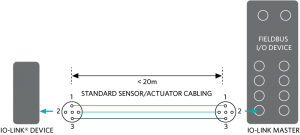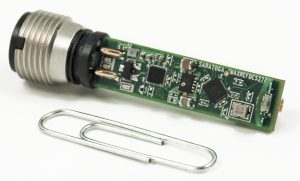
The IO-Link master establishes the connection between the IO-Link devices and the automation system. As a component of an I/O system, the IO-Link master is installed either in the control cabinet or as remote I/O which communicate via regular fieldbus networks to the controller.
EXAMPLE IO-LINK SENSORS: TINY, SMART & CONNECTED
Today’s factories rely more on automation and less on manual labor. With this increased use of automation & robotics comes the increased need for proximity sensing. Proximity sensors are devices that can sense when an object is a specific distance away from a reference point location. They are able to act as a switch by flipping when the target object passes a predefined distance threshold. They can also provide continuous readings when objects are changing distances within a sensor’s range. Several types of proximity sensors exist today such as optical, inductive, capacitive, ultrasonic, magnetic, and even mechanical.
Shown here is a tiny IO-Link proximity sensor with an IR receiver, matching IR LED driver, IO-Link transceiver, and energy-efficient step-down converter all on an 8.2mm x 31.5mm printed circuit (PC) board. The Maxim reference design in Figure 4 consists of an industry standard Maxim Integrated IO-Link device transceiver (MAX14821), a tiny low-dropout linear regulator (MAX8532), an efficient high-voltage step-down converter (MAX17552), a Renesas ultra-low-power 16-bit microcontroller (RL78) utilizing TMG TE’s IO-Link device stack, and a Maxim Integrated proximity sensor (MAX44000).

This reference design highlights an ability to develop ultra-small IO-Link sensors that are versatile and powerful enough to be integrated within an actual assembly line.
ENABLING IO-LINK DESIGN
There are various types of IO-Link sensors that are coming available in the market which range from temperature to distance and even light curtains with multiple light beams. To enable the interface of these sensors with legacy programmable logic controllers (PLCs) we see a host of gateways that can translate multiple IO-Link inputs to a single fieldbus. Some of the newer PLC designs are incorporating IO-Link master functionality built-in, so that they can communicate directly with the IO-Link sensors. This is enabled by the availability of integrated IO-Link transceiver devices in small, power efficient form-factors.
For example, the MAX14824 is an IO-Link master interface that integrates an IO-Link physical layer transceiver with an auxiliary digital input and two linear regulators in a small 4mm x 4mm, 24-pin TQFN package. The device supports all the IO-Link data rates and is compliant with IO-Link v.1.0 and v.1.1 Physical Layer. Figure shows the typical operating circuit for IO-Link Master functionality with such a device




